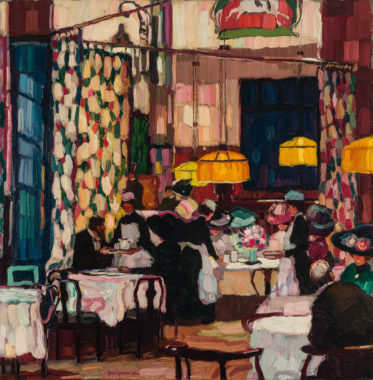Goossens, Josse
Sold Artworks
Biography
Josse Goossens
1876 Aachen – 1929 Regensburg
As a student at the Düsseldorf Academy Josse Goossens exhibited a particular affinity for monumental painting and quickly went on to make a name for himself in the field. The murals he executed for public bodies and private patrons draw largely on religious and historical themes. They are characterised by broad planar treatment and a predilection for decorative effect. The emphasis on decorative effect is also evident in his easel paintings. From the turn of the century onwards he frequently painted en plein air, producing a large body of plein-air sketches which often served as the basis for studio paintings.
In 1910, Goossens moved from Düsseldorf to Munich and began to specialize in interiors and still lifes. He turned increasingly to motifs centered around the city of Munich – scenes chronicling carefree moments across different sectors of the population. Depictions of religious processions, fairgrounds and circus performances capture the leisure activities of ordinary people while afternoon concerts, coffeehouse scenes and masked balls reflect the privileged lifestyle of the haute bourgeoisie. The special appeal of Goossens’ paintings derives not only from the motifs he portrays. It also lies in his bravura painting techniques. Broad strokes of impasto in vibrant tones are juxtaposed to create a flickering, mosaic-like effect and rapid, free-flowing brushwork enlivens the picture surface. This orchestrated riot of tones creates a sense of visual lightness. The representational character of the painting steps into the background and its atmospheric quality is accentuated.
Goossens’ work shows the influence of late Impressionism and its resulting proximity to the work of Die Scholle, a feted Munich artists’ group, is certainly one reason for his rapid establishment in Munich artistic circles. In 1911, his paintings began to appear in the magazine Jugend and to be shown at the annual exhibitions organised by the Munich Secession. Franz Josef Brakl, a leading Munich-based art dealer, became his dealer. Even today, Goossens’ depictions of the Auer Dult, a traditional Munich market, and his images of the Oktoberfest, the Zirkus Krone circus ring, the ballroom in the Deutsches Theater, the Magdalenenfest in Nymphenburg and the amusement park on the Theresienhöhe convey a highly evocative impression of the carefree attitude towards life that marked the Prinzregentenzeit.
PDF Download